I think I remember first going to Moab back in 2004 looking up at these desert towers thinking how spectacular they were yet couldn’t comprehend actually trying to climb them. As I hadn’t been to the Moab area in years, I was definitely looking forward to getting back down there this Fall/Winter to climb one of these towers with my good bud Jesse Hill. I had been doing alot of climbing all summer and was feeling confident at 5.9 trad. Jesse was always like “Just say the word, Brando” and we’d be off to the desert. If we were going to make a move at the iconic Castleton Tower above Castle Valley, I felt now was the time before we set off for Aconcagua and the winter really set in. I always want be solid at the climbing route grade or just a bit over-prepared as I like to climb the pitches cleanly, i.e. without resting on gear and struggling up. The last thing I want to do is attempt this route under-prepared and having to rest on gear. I just don’t feel very accomplished or good about myself when that happens. I like to give the route its due respect and be solid at the grade for an attempt. Jesse & I had our sights set on the classic 5.9+ Kor-Ingalls route up Castleton Tower marked as one of the fifty classic climbs of North America in Steck & Roper’s book “Fifty Classic Climbs of North America”. The Kor-Ingalls route was the first route up the 6,656′ tower ascended by Layton Kor and Huntley Ingalls in 1961. This route ascends the huge west facing dihedral on the south side of the tower, so it sees alot of sun in the cooler months, which is always a plus.
When our good buddy Steve Cizik sent an email out early in the week saying he had the weekend free for a camp and climb of something, I emailed him back saying Castleton Tower may be on the agenda. He was immediately on board as was our other really good friend J Weingast. Thus, we had a foursome and two teams of two, which would be perfect. Odd numbers are just too complicated and inefficient. Jesse & Steve left Denver friday evening, picked up J & I in the Vail Valley, and we were off to the desert. The forecast was for sunny skies and around 60 degrees, just perfect climbing weather. The drive reminded me of all the countless roadtrips we would all take back in the day around the state to climb these things called 14ers. It was a fun drive. We arrived at the Castleton Tower campground and trailhead around 11pm, hung out for a bit, and then spread our pads & bags out for a sleep out under the full moon.
Our alarm was set for 6am in order to be on the trail by 7am and hoping that we would get ahead of any other parties attempting the route. There were numerous other camping parties at the trailhead upon our arrival which had us a bit concerned. However, we were the only ones stirring at 6am, so our concerns were put to rest. We ended up being the only climbers on the Kor-Ingalls route and only one of two parties on the entire tower that day. The other party was a team of two on Castleton’s 5.11b North Face. The nice approach hike took just shy of an hour to the base of Kor-Ingalls. I always like a good approach hike with a heavy pack as its a good warm-up for the climb ahead, in my opinion.

Just gorgeous country & morning light on the approach. I really missed the Moab area and am so glad we made this climb happen
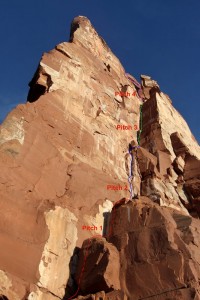
The 5.9+ Kor-Ingalls route up Castleton Tower in 4 pitches. The Kor-Ingalls route is listed in Steck & Roper’s “Fifty Classic Climbs of North America”
J & I paired together as team Chalk-Weingast and after racking up J took off leading the very fun 120′ 5.7 Pitch 1. A great 25′ dihedral led to a big ledge and two 25′ awkward squeeze chimneys ensued which eventually dumped you out on a large ledge with belay anchors. J did a wonderful job leading this pitch – I think he does well in tight squeeze chimneys as he loves caving and getting in tight spots. Even on top-rope, I had some tough moves and positions in these squeeze chimneys on Pitch 1 somewhat due to my SLR camera on my harness, but my hat was off to J for a great lead.
I was extremely hot upon reaching J at the Pitch 1 belay anchors, so I took off my Marmot windshirt jacket, wrapped it up in a rock, and sent it sailing down to the base of the route obviously letting team Hill-Cizik know first of my intentions. Jesse was belaying Steve at the time I sent the shirt and rock sailing 120′ yet Jesse yelled and darted out of the way of the incoming missle. I guess my throw was pretty dead on. We all wished we had captured that episode on video as it was pretty hilarious. J & I swapped my rack and I took off up the slightly intimidating 100′ 5.8 Pitch 2. I have read reports that some folks thought this pitch was harder to lead than the 5.9+ crux Pitch 3, though I didn’t think that was the case. It was a solid 5.8 crack lead for sure, but nothing runout like Pitch 3. I could have used two #4 camalots as I had to move one with me, but it worked out and I was soon at the Pitch 2 belay anchors.
J cleaned Pitch 2 nicely and cruised up to me while Jesse started the lead of the same pitch behind him. The whole time I was belaying J up Pitch 2 I was scoping out the first 30′ of the crux 5.9+ Pitch 3. It was definitely a bit intimidating, though I was excited. I was able to stem my way up 6′ or so and found some old webbing wrapped around a chockstone in the off-width chimney. It seemed solid, so I ran a biner and sling on it. I then mantled up to a small ledge on which I could stand and was able to clip the first of three bolts on the pitch. This bolt is well placed and protects the first 5.9 crux move of the pitch. It was a tough sequence of moves, but the goal was to move slightly right past the bolt and pull yourself up to a decent rest before the big off-width chimney.
I then entered the large off-width chimney, placed a cam in a chockstone, moved up another 8′ or so and clipped the second of three bolts on the right face in the chimney. Stemming my way up another 5′ in the chimney, I was able to clip the last of three bolts on the face itself just below the 5.9+ crux moves. The 8′ crux section involves either face climbing to the left, stemming on smooth calcite, or laying back the off-width. I chose to lay back the off-width, but don’t ask me why. Steve thought I was nuts for doing it this way. I should have face climbed to the left as he did. Nevertheless, after laying back the crux, I slid my whole left leg and knee into the chimney locking it out to give my arms a rest. I was a good distance above the last bolt and needed to get some sort of protection in. I was able to slide in a small cam into a crack deep in the chimney. After a few more big chimney squeeze moves, I found myself way above my last cam, yet was able to get a very small nut in a tiny crack of a chockstone within the off-width chimney. It didn’t inspire alot of confidence, but is what I needed mentally. I then entered the chimney completely and was able to body stem up using decent holds inside the off-width until I could move out on the face and place my last 0.5 cam horizontally in a crack to protect the last big mantle move before the Pitch 3 belay anchors. Pitch 3 was indeed the crux of the route in my book. It had several small cruxes comprising the pitch, some very runout sections, and not many places for good protection. Thank goodness the bolts were there, however. All in all, a heck of a pitch and a solid hard 5.9. I then anchored myself and brought J up Pitch 3.
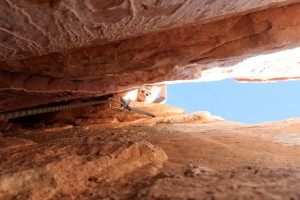
J’s perspective up at me in the Pitch 3 off-width with about 15′ to go until he reaches me and the belay anchors
Steve said that from the Pitch 1 belay ledge he had a great view of me leading Pitch 3 at the same time Jesse was below leading Pitch 2. J soon joined me at the Pitch 3 belay anchors, I gave him my rack, and he took off up the final 80′ 5.7 Pitch 4. Steve was beginning the lead of the crux 5.9+ Pitch 3 at the same time and I was able to give Steve some beta from above as he led the pitch. He did a great job, but agreed with me that there were some serious nerve-racking sections and placements. J cruised the final Pitch 4 and before I knew it, he was on top at the Pitch 4 belay anchors. Steve reached me at the Pitch 3 belay anchors and we congratulated each other on a tough lead. The airy Pitch 4 was probably the most fun pitch of the route. Great moves and nothing too tough.
J & I then belayed each other up the final 5′ mantle to the summit plateau. It was a great feeling to be on the summit of Castleton Tower. We hung out for a bit, checked out the North Face rappel anchors, signed the summit register, and enjoyed the views.
Jesse & Steve sooned joined us on the summit plateau and took in the views and sense of accomplishment as well. Castleton is such an airy tower that you really get the feeling you are high up in the sky when you are on the summit. We spent over an hour on top taking pictures, swapping stories, and enjoying each other’s company. Looking over the North Face, there was a party of two on the first pitch, so we decided to descend Kor-Ingalls as there was no one behind us on that route.
Three double rope rappels later we were safely at the base of Kor-Ingalls. The first long rap dropped us at the top of Pitch 2. The second shorter rap put us at the top of Pitch 1. And then the third rap put us at the base of the route.
The climb went so smoothly that we were almost home free without any snags or delays. However, never count your chickens before they hatch. I came down the last rap last, tried to pull the ropes, and something was stuck. After 15 minutes, we just could not free the ropes. It seemed the knot was stuck on the final lip of the Pitch 1 belay ledge. Moving the ropes downhill and putting some serious muscle into whipping the ropes off the lip, we finally freed the knot and were able to pull the ropes. Worst case, we would have climbed Pitch 1 again, but who wants to do that 🙂 After some lunch and packing up, we were back at the car by 3pm for the long ride back to Vail. However, the ride was full of excitement and stories. You know its a good climb when you chat about it for hours on the ride home.
I think Castleton was a terrific conclusion to a fun-filled season of good rock climbing with Kristine and the boys. Now, its seriously time to swap out the rock gear (just for now) for mountaineering boots and warm clothing for higher altitude adventures. Kristine & I leave Decemeber 22 for Aconcagua in Argentina with our friends Brett Wamsley & Maura Stack-Oden and we couldn’t be more excited. However, higher peaks around the state will be on the menu for the next few weekends. The next day after Castleton, we took a nice couple hour hike up Atlantic Peak with Rainie, Kona, J Weingast, & Mike Santoro. Atlantic is one of our local favorites since its so close, is relatively short, and gets you close to 14,000′. From desert towers to snow-capped peaks in a weekend with great friends and my wife! Couldn’t ask for much more!

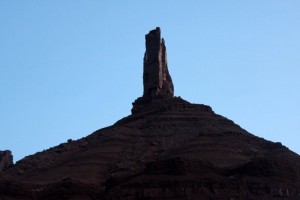
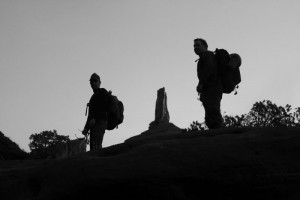
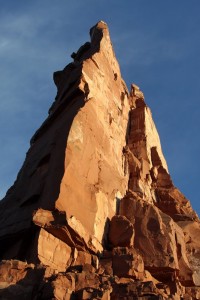

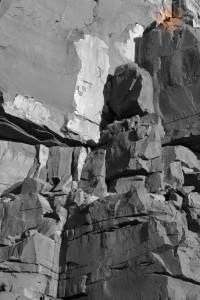

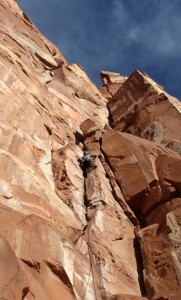


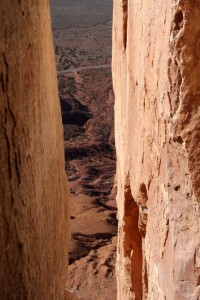
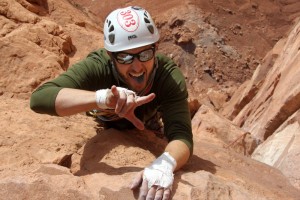
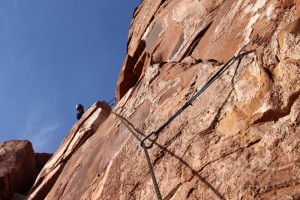
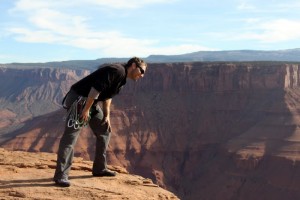
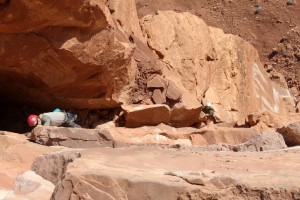

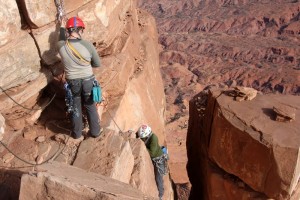


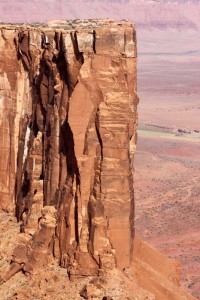
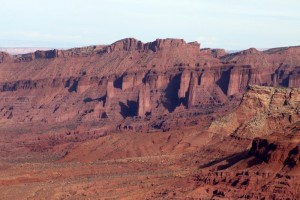


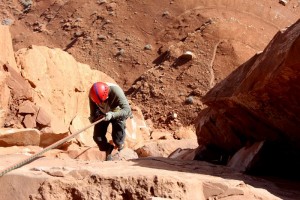

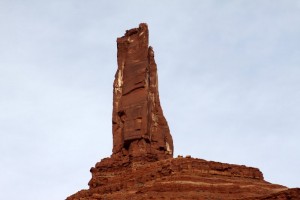


 Follow
Follow












